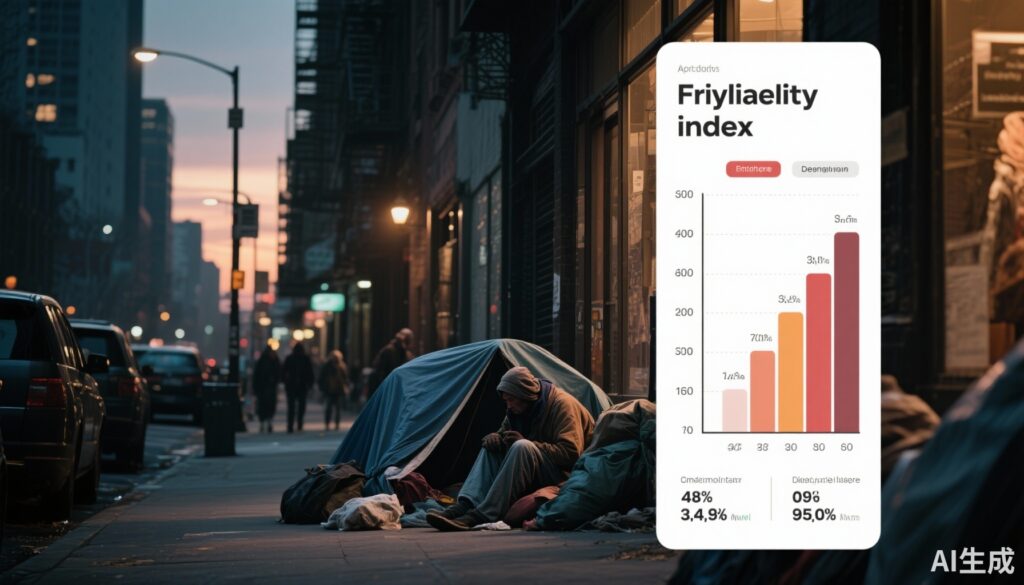Study Background
Frailty is a multidimensional clinical syndrome characterized by decreased physiological reserves and increased vulnerability to adverse health outcomes. Traditionally viewed as a condition affecting the elderly, frailty encompasses impairments across multiple physiological systems leading to heightened susceptibility to stressors such as illness or injury. Emerging evidence suggests that frailty can manifest prematurely in marginalized populations, including people experiencing homelessness (PEH), due to complex interactions of chronic health conditions, social deprivation, and unstable living conditions. PEH suffer disproportionately high levels of physical and mental health problems, often compounded by inadequate healthcare access and socioeconomic disadvantage. Understanding the prevalence and associated factors of frailty in this group is crucial for targeted health interventions and policymaking.
Study Design
This investigation represents a cross-sectional secondary analysis of health needs survey data collected from PEH across primarily urban areas in England between 2012 and 2021. Homeless Link conducted interviewer-administered surveys in three waves, capturing comprehensive health and sociodemographic information. Using a modified Delphi method with expert input, researchers constructed a frailty index from available variables following established frailty index construction guidelines. Participants with at least 80% completion of these variables were included in the analysis. Frailty was defined based on frailty index scores ≥0.25, with pre-frailty identified by scores between 0.08 and 0.25. Multinomial logistic regression was utilized to assess associations between frailty status and sociodemographic characteristics, adjusting for age, sex, accommodation status, employment/education engagement, and immigration status.
Key Findings
The study analyzed data from 2288 PEH, predominantly aged 18-59 (94.2%). Strikingly, 41.5% met criteria for frailty, while 43.8% were classified as pre-frail. Frailty was evident even among younger adults, with 26.6% of individuals aged 18-29 identified as frail, underscoring early onset in this population.
Age emerged as a strong predictor: those aged 50-59 had an over eight-fold increased risk of frailty compared to those aged 18-29 (adjusted risk ratio [aRR] 8.30, 95% CI 4.86-14.16). Female PEH had more than twice the risk of frailty compared with males (aRR 2.30, 95% CI 1.57-3.37). Engagement in employment, volunteering, or education was protective, with those not engaged demonstrating a threefold increased risk of frailty (aRR 3.05, 95% CI 1.97-4.71). Interestingly, non-UK nationals exhibited significantly lower frailty risk compared to UK nationals (aRR 0.20, 95% CI 0.12-0.33). Sleeping rough (outside) was associated with a reduced likelihood of frailty relative to PEH who were housed after homelessness (aRR 0.36, 95% CI 0.17-0.76).
Patterns identified in pre-frailty mirrored those observed for frailty, suggesting a continuum of vulnerability within the homeless population.
Expert Commentary
This study is notable as the largest to date examining multidimensional frailty among PEH in England, shedding light on a non-geriatric population with alarming health vulnerabilities. The use of a frailty index constructed via expert consensus adds methodological rigor uncommon in homelessness research. The findings emphasize that frailty in PEH is not merely a consequence of chronological age but is driven by complex socioeconomic and environmental factors.
The unexpectedly lower frailty prevalence in rough sleepers compared to those recently housed may reflect differences in health-seeking behavior, survival bias, or segregated subpopulations requiring further investigation. Gender disparities underline the need for tailored approaches addressing unique health and social challenges faced by homeless women.
Limitations include the cross-sectional design precluding causal inference and potential selection bias given reliance on survey participation. Despite these, the study’s large sample size and comprehensive adjustment for confounders enhance its generalizability to urban PEH in England.
Conclusion
This research reveals that frailty is highly prevalent among PEH in England, including younger adults, with substantial links to sociodemographic factors such as age, gender, employment engagement, and immigration status. These insights call for integrated health and social policies focusing on early identification and intervention for frailty in this vulnerable group. Multidisciplinary services incorporating healthcare, social support, and empowerment through education or employment may mitigate frailty progression and improve outcomes. Future longitudinal studies are necessary to elucidate causal pathways and evaluate intervention effectiveness.
Funding and Clinical Trials Registration
This study was funded by the National Institute for Health and Care Research (NIHR). No clinical trials registration was applicable.
References
Dawes J, Bagkeris E, Walters K, Burton A, Hertzberg D, Frost R, Palipane N, Hayward A. Prevalence of frailty and associated socioeconomic factors in people experiencing homelessness in England: cross-sectional secondary analysis of health needs survey data. Lancet Healthy Longev. 2025 Aug;6(8):100745. doi: 10.1016/j.lanhl.2025.100745. Epub 2025 Aug 21. PMID: 40850329.



